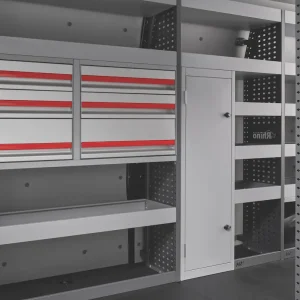The 4×4 van sector is by some measure the smallest category in the light commercial vehicle market but one for which there will always be demand.
These vehicles fill the needs of predominantly private customers based in rural areas who need some off-road capability. They also serve utility companies and emergency services that have to reach inaccessible locations in difficult terrains.
In 2014, sales of 4×4 vans jumped more than 27% from 6881 to 8763 units, according to the SMMT. This represented the second biggest growth of any segment other than the 2.0-2.5t grouping, which increased by 42%.
Sales of the off-roaders in May grew by a market-leading 33% to 828 year-on-year and growth in the first five months of the year also led the way – up 34% from 3575 to 4800 compared to the same period last year.
Korean brand Ssangyong is keen to muscle in on the action and in February, aside from its Korando Sports pick-up truck, it launched two new 4×4 models.
The Rexton W CSX is a commercial take on the manufacturer’s third generation Rexton off-roader. It is essentially the Rexton W SX with the back seats removed and replaced by a flat load floor. The 2.0-litre 155hp CSX comes with six-speed manual transmission and low-range 4WD to aid its progress when it ventures off-road. It does get equipment such as air-conditioning, cruise control and leather trimming but otherwise it is functional and most likely to attract interest through its price tag, which is £18,495, excluding VAT.
This compares to £25,000 for Mitsubishi’s Shogun, which Ssangyong’s UK boss Paul Williams cites as a rival.
“The new Rexton W CSX has an almost unrivalled position in the LCV sector,” Williams claims.
The CSX has a payload of 740kg, not far short of the Shogun’s 755kg but its towing limit of 3.0t falls short of the Shogun’s 3.5t.
Ssangyong has also introduced two LCV versions of its smaller Korando model – the 2WD Korando CS and the 4WD Korando CSX, which it describes as a “go-anywhere vehicle for service engineers”.
It has a £14,295 price tag, a payload of 433kg and 2.0t towing capacity, which is double that of the Peugeot Partner with traction control.
Mitsubishi has carved out a unique section of the market for itself with its Outlander 4Work. The diesel derivative, a favourite with country vets, according to the brand’s UK boss Lance Bradley, was supplemented with a plug-in hybrid 4Work model late last year.
No other brand, as yet anyway, offers anything like it. Qualifying for the Government’s Plug-In Van Grant and capable of travelling for more than 30 miles on battery power before reverting to petrol-hybrid propulsion, the PHEV 4Work has an official fuel econsumption of 148mpg. A 2.0-litre petrol engine and a pair of 60kW electric motors connected to a lithium-ion battery pack drive the vehicle.
Ford added the All-Wheel Drive model to its Transit van range in October 2014 with a price point starting at under £21,000, excluding VAT.
This version is available only in Base specification, although a wide range of options is up for grabs and customers can choose from a variety of bodystyles: L2H2 (medium wheelbase, medium roof), L2H3, L3H2 and L3H3.
Ford claims that compared to the previous AWD Transit the new electronically controlled system delivers better traction in low friction conditions, full integration with the ESC and traction control systems and a new AWD Lock mode for enhanced grip in extreme conditions such as snow and sand.
Mercedes 4×4 Sprinter, which won the What Van? 4×4 Van of the Year award in 2013, is a well established favourite with customers requiring a load lugger with some extra traction control – a fact recognised by wind turbine maintenance firm Siemens, which commissioned 50 of the vans in June from Midlands Truck & Van to service wind farms nationwide.
Due to such low volumes, Tim Cattlin CV editor for CAP Monitor, admits it is almost impossible gauge trends for 4×4 vans in the used market. However, he says the one that does stand out is the Sprinter – making good money at auction and reliably popular with forestry and agricultural traders “who will pay handsomely for a piece of equipment that is suited perfectly to their profession and where the capital cost at new is high”.





